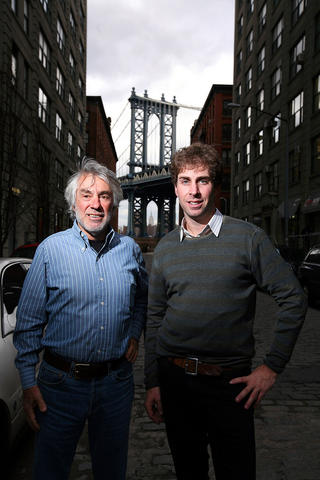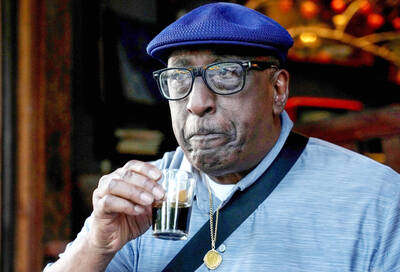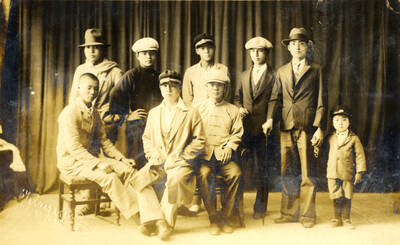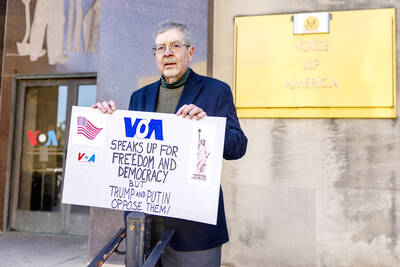George Dombek pays rent on his 130m2 light-filled studio at 20 Jay St with his paintings, which lately focus on water towers and upside-down tin pails on posts.
The Galapagos Art Space will pay around US$20 per square meter a year when it moves into a 102-year-old, 929m2 former stable at 16 Main St this spring.
St Ann's Warehouse, a performance space in an old spice-milling factory at 38 Water St, pays no rent at all.

PHOTO: THE NEW YORK TIMES
Some 1,000 artists and arts organizations are now working in the Dumbo section of Brooklyn, courtesy of the developers David Walentas and his son, Jed, partners in Two Trees Management. Operating on the principle that cultural ferment makes a neighborhood hot, Two Trees has offered creative people rents that they cannot refuse.
"It adds value to any neighborhood," David Walentas said in an interview at a conference table in his unflashy Dumbo office. "It's like good architecture. Good architecture is cheap and adds value. People will pay a premium for it."
Yet given the pace of gentrification, the future of the neighborhood's artists - and of Dumbo's artistic character - remains uncertain. Two months after Dumbo, named for its area Down Under the Manhattan Bridge Overpass, was designated a landmark in December, the City Planning Department proposed last week that the neighborhood be rezoned to allow taller buildings in high-density areas. Dumbo is historically considered to be the area between the Brooklyn and Manhattan Bridges and between the East River and Brooklyn-Queens Expressway, but blocks on the other side of the Manhattan Bridge are now often considered part of the area.
Mitchell Moss, a professor of urban policy and planning at New York University, gives David Walentas points for figuring out how to make a neighborhood vital. "He understands that you have to have creative energy," Moss said. "This is an intelligent and strategic move."
But some artists are troubled by the notion of developers using artists to help invigorate or market a neighborhood even as artists are priced out of more established areas.
"This really represents the broader picture, where cities are becoming impossible places for creative producers to live and work, where the notions of loft living and 'bohemian' become selling points in the development of real estate," the artist Barbara Kruger said. "Artists have nowhere else to turn so they take those work spaces. It's their work to make the neighborhood cool; then they can be moved out."
Other artists say David Walentas has a long-term commitment to culture in Dumbo and is simply speeding along a process that can't easily happen on its own because of rising commercial real-estate prices. "He's doing artificially what used to happen naturally over a longer period of time, like forcing a tulip bulb," said the artist Chuck Close, who serves on the board of the Marie Walsh Sharpe Art Foundation, which is based in Dumbo. "It doesn't happen organically the way it used to. Now you need a break."
"Clearly, he wants to make a buck," he added. "But it's community building."
The Two Trees developers, who own about 280,000m2 of property in Dumbo, tell their tenants that they will try to find other places for them in the area if their spaces are sold or developed. But they make no guarantees.
"Things change," David Walentas said. "Some will stay, some will die, some will move, some will go out of business. We can't solve all their problems.
The developers are up front with the tenants about the short-term nature of their leases.
"It was always straightforward," said Kathleen Gilrain, the executive director of Smack Mellon. "He doesn't spring stuff on us. Buildings are developed all over New York City, and those landlords don't give any space away."
When Two Trees converted 70 Washington St into condos, it offered almost every artist in the building below-market rates at one of its other buildings, 20 Jay St or 55 Washington St, and 80 percent accepted. "We're in a unique position to do these things because we own the whole neighborhood," Jed Walentas said.
They don't own all of it. While the Walentases say they would eventually like to move the St Ann's Warehouse organization to the brick ruins of the 19th-century Tobacco Warehouse in Empire-Fulton Ferry State Park, that property belongs to the state. They also want to convert the Empire Stores Warehouse, on Water Street between Dock and Main Streets, into studio and gallery space, but the state owns that too.
Affordable studios, galleries and stages are hard to come by in New York City. The Galapagos Art Space was on the verge of leaving Williamsburg, Brooklyn, for Berlin because its monthly rent had risen by US$10,000. David Walentas offered the company below-market space. "He's doing what the city should be doing," said Robert Elmes, director of Galapagos. "He's proving that it works."
The city, for its part, appreciates what Two Trees is doing.
"In an ideal world everyone would have space to work in perpetuity," said Kate Levin, the cultural affairs commissioner. "That's not the reality of New York real estate."
"He doesn't sweep in in the middle of the night and evict people," she added. "Providing space for people to make work and for people to come see it is a huge commitment."
David Walentas clearly enjoys coming to the rescue. "We've been very, very generous because I like it," he said. "I don't need the money. It's a way of putting people in my buildings."
On a recent tour of Dumbo he walked through some of these buildings, like the paint-splattered studios of the Triangle Arts Association at 20 Jay St (rent: free), where a visiting French artist, Gregory Forstner, was working on canvases of dogs in combat helmets. Walentas also showed off Smack Mellon's soaring new two-level gallery space on Plymouth Street, where huge pieces of sculpture were installed, and other tenants like the Brooklyn Arts Council, the Brooklyn Stained Glass Conservation Center and Dancing Diablo, an animation company (as well as the chocolate shop Jacques Torres and the bakery Almondine on Water Street).
"I'm very proud," Walentas said. "I tell people I've done a lot of things. They matter; they don't matter. In 100 years Dumbo will matter."

On April 26, The Lancet published a letter from two doctors at Taichung-based China Medical University Hospital (CMUH) warning that “Taiwan’s Health Care System is on the Brink of Collapse.” The authors said that “Years of policy inaction and mismanagement of resources have led to the National Health Insurance system operating under unsustainable conditions.” The pushback was immediate. Errors in the paper were quickly identified and publicized, to discredit the authors (the hospital apologized). CNA reported that CMUH said the letter described Taiwan in 2021 as having 62 nurses per 10,000 people, when the correct number was 78 nurses per 10,000

As we live longer, our risk of cognitive impairment is increasing. How can we delay the onset of symptoms? Do we have to give up every indulgence or can small changes make a difference? We asked neurologists for tips on how to keep our brains healthy for life. TAKE CARE OF YOUR HEALTH “All of the sensible things that apply to bodily health apply to brain health,” says Suzanne O’Sullivan, a consultant in neurology at the National Hospital for Neurology and Neurosurgery in London, and the author of The Age of Diagnosis. “When you’re 20, you can get away with absolute

May 5 to May 11 What started out as friction between Taiwanese students at Taichung First High School and a Japanese head cook escalated dramatically over the first two weeks of May 1927. It began on April 30 when the cook’s wife knew that lotus starch used in that night’s dinner had rat feces in it, but failed to inform staff until the meal was already prepared. The students believed that her silence was intentional, and filed a complaint. The school’s Japanese administrators sided with the cook’s family, dismissing the students as troublemakers and clamping down on their freedoms — with

As Donald Trump’s executive order in March led to the shuttering of Voice of America (VOA) — the global broadcaster whose roots date back to the fight against Nazi propaganda — he quickly attracted support from figures not used to aligning themselves with any US administration. Trump had ordered the US Agency for Global Media, the federal agency that funds VOA and other groups promoting independent journalism overseas, to be “eliminated to the maximum extent consistent with applicable law.” The decision suddenly halted programming in 49 languages to more than 425 million people. In Moscow, Margarita Simonyan, the hardline editor-in-chief of the